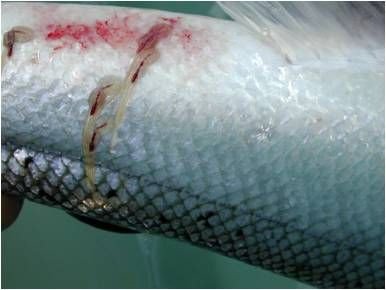What Are Sea Lice? Facts About The Ocean’s Flesh-Eating Crustacean

Sea lice normally feed on fish flesh but they might have made a meal out of an Australian teenager’s feet this weekend. Sixteen-year-old Sam Kanizay was reportedly soaking his legs at the Dendy Street Beach in the Brighton area of Melbourne after playing soccer, but when he came out of the water his feet and legs were covered in blood. The bleeding did not stop and he was rushed to the hospital.
“As soon as we wiped [his legs] down, they kept bleeding,” father Jarrod Kanizay said. “There was a massive pool of blood on the floor [at the hospital].”
Some are speculating that sea lice were what attacked the teen.
Read: Mystery Creatures Attack Teen at Australian Beach
According to the Alaska state Department of Fish and Game, sea lice are small, oval-shaped crustaceans that are often seen hanging on to salmon — they are parasites. At first they hang onto fish with hooked antennas but after they grow they start using suction, and at this larger phase of development can be deadly to the fish.
“The lice are able move, or ‘graze,’ on the host fish’s body, preferring the head, back and perianal areas,” the department says. “Their preferred diet is mucus, blood and skin.”
And they are widespread in the ocean, found all over the globe: “They constitute the largest source of protein in the world’s oceans in their early larval stages,” the ADFG says.
The creatures are a type of copepod, a Greek word for “oar-footed” because they have a “pair of swimming legs … that are moved together, like the oars of a sculling shell,” the Smithsonian National Museum of Natural History explains. The copepods are a diverse group of crustaceans and the “most numerous” of the multi-celled organisms in the water.
In the case of the Australian teenager’s bloody experience, whatever attacked him did it at a beach along Port Phillip Bay, which connects to larger bodies of water, like the Bass Strait between mainland Australia and Tasmania. On either side of that inlet are the Indian and Pacific Oceans.
According to the New York Times, the teenager might have encountered a group of hungry sea lice and that’s why he was so bloodied, as opposed to the usual result when a sea louse finds a human: small pricks in the skin that have the look of a rash.
The BBC reported that Sam Kanizay had felt pins and needles while he was submerged up to his waist, and thought he was just rubbing sand off his legs when he got out.
There was some debate, however, as to whether the sea lice were the actual attackers of the boy’s feet.
Some experts have said the bites were caused by sea lice, and Jarrod Kanizay later returned to the beach with a net to capture the flesh eaters and filmed a water-filled container with the sea lice after throwing in a raw steak — the parasites attacked the meat immediately. But University of New South Wales associate professor Alistair Poore told the New York Times that not only were the captured swimmers actually a type of amphipod that doesn’t bite humans, but also having caught them doesn’t mean they were the ones eating the teenager’s skin.
“You can attract a lot of animals in the sea with raw meat,” Poore told the New York Times. “Even though it’s interesting, it doesn’t prove to me they were the ones that bit his legs.”
Read: Meet the Biggest Shark Ever
He added, however, that sea lice might become more aggressive if there weren’t a lot of fish around to feast on, and it was possible that a large number of sea lice could have done this.
It wasn’t the only incident in recent days in which someone stepped into the ocean and later walked off the beach with a flesh-eating creature. A woman on vacation at Myrtle Beach in South Carolina reportedly cut her leg and then went into the water, where flesh-eating bacteria got into the wound. By the time she got home, she had purple blisters on her leg and low blood pressure, and doctors were going to amputate the limb to save the rest of her body.
© Copyright IBTimes 2024. All rights reserved.





















